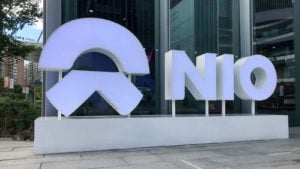Read The Full Article On: Investorplace
TSLA is the obvious comp for Nio stock — but it’s also a warning
By Vince Martin, InvestorPlace Contributor Jan 29, 2021, 6:15 am EST
At its core, the case for Nio (NYSE:NIO) stock is somewhat straightforward. Investors are looking for the “next” Tesla (NASDAQ:TSLA), or perhaps the “Tesla of China,” as some have put it.

Source: Andy Feng / Shutterstock.com
Obviously, that analysis is overly simplistic. Nio and Tesla are not the same. Nio doesn’t have the energy businesses that Tesla does. The U.S. and Chinese markets are quite different. Nio faces more significant competition, not just from Tesla itself and direct rival Xpeng(NYSE:XPEV), but from the nearly 500 electric vehicle manufacturers in China.
Still, the broad point holds, at least somewhat. Much like, say, Netflix(NASDAQ:NFLX) and iQiyi (NASDAQ:IQ), the comparisons are imperfect but still valuable. Bulls believe the global EV market will explode higher, and they believe Nio can capitalize in China the same way Tesla did in Western markets.
That doesn’t necessarily mean Nio stock will mimic Tesla stock. But it doesn’t have to. After all, TSLA has been literally one of the greatest stocks of all time, rising an incredible 26,000% since its 2010 initial public offering (at a split-adjusted price of $3.40). Even if the returns in NIO stock aren’t quite as good — and they almost certainly won’t be — there’s still a lot of upside to be had.
In that context, it’s worth reviewing where Tesla sat at similar points in its growth to where Nio sits now.
Nio 2020/2021 vs. Tesla 2015
In terms of deliveries, Nio in 2020 looks roughly similar to Tesla in 2015. Nio last year delivered 43,728 vehicles, with the figure more than doubling year-over-year. In 2015, Tesla deliveries totaled just over 50,000, up nearly 60% against 2014 levels.
Revenue figures are a bit different. Tesla’s deliveries in 2015 consisted of higher-priced cars; many Model X units at the time sold, with options, for over $100,000. And so Tesla’s 2015 revenue of $4 billion is substantially higher than the $2.5 billion analysts expect Nio to generate in 2020. Nio almost certainly clears $4 billion in 2021; Wall Street consensus actually is closer to $5 billion.
Both companies were unprofitable at this point in their growth. On an adjusted basis, Tesla lost $295 million in 2015. Nio’s losses in 2020 will be far higher, likely over $700 million, with the Street looking for the figure to improve by roughly half the following year.
Quantitatively and qualitatively, the comparison between Nio and Tesla is not necessarily a clean one. But we can say, roughly speaking, that where Nio is positioned now, at least financially, about where Tesla was a little over five years ago.
Good News for NIO Stock
From one perspective, that fact is enormously bullish for NIO. After all, TSLA closed 2015 at a split-adjusted $48. It’s risen roughly 18x since then.
Nio is not likely to post the same kind of returns. An 18x rise from the current price would mean a market capitalization of $1.6 trillion, and potentially higher if (as is likely) the company has to sell more stock to fund near-term losses.
But even something short of TSLA still means a huge run for NIO. After all, investors at the end of 2015 would have done well if they paid $448 for TSLA stock instead of $48.
At that $448 price, investors still would have doubled their money in a little over five years, a roughly 14% annualized return. In other words, TSLA could have reached a $290 billion market capitalization at that point — over 70x revenue — and the stock would have roughly priced in its future appreciation. (Note that market cap gains in this model — nearly triple — outpace the share price owing to dilution over that stretch.)
For Nio, 70x 2021 revenue suggests a market capitalization of $350 billion. That’s nearly 300% above the current level.
Yeah, But …
All this math is basically a long way of saying something simple: if Nio really is the next Tesla, NIO stock is too cheap. The problem is that is a huge, enormous, ‘if’.
One obvious risk is that TSLA itself is overvalued. Again, the stock has soared 18x in barely five years. A market capitalization over $800 billion makes it the sixth-most valuable company in the world. I personally think that rally is due to end, and other investors no doubt agree.
Another, again, is competition. There are other EV manufacturers in the West, but none as yet have risen to Tesla’s level. But Xpeng delivered nearly 13,000 vehicles in Q4, roughly three-quarters as many as Nio despite later production and a far smaller 2019 base. Tesla itself will be a fearsome competitor; in fact, it’s difficult to argue both that Nio will outcompete Tesla and that the latter company is worth more than $800 billion.
There’s Tesla’s energy business, which somewhat quietly has built value. The Energy Generation and Storage segment posted revenue of $1.2 billion through the first nine months, including third quarter growth of 44% year-over-year.
And there’s the China discount. For a number of reasons, investors don’t pay the same price for IQ as for NFLX, or for Alibaba (NYSE:BABA) as Amazon.com(NASDAQ:AMZN).
LOUIS NAVELLIER REVEALS HIS #1 STOCK FOR 2021
Be Careful Out There
Given all those factors, it’s reasonably argue that Nio’s positioning relative to Tesla five years ago is bullish — but its valuation is not. Yes, the market is assigning roughly one-fourth the price-to-sales multiple for Nio that it ‘should have’ for Tesla five years ago, but there’s almost no reason to suggest that the two multiples should be comparable.
Tesla in 2016 was a better business than Nio is in 2021. That’s not to say Nio is a bad business, but Tesla’s first-mover advantage created a massive opportunity that Nio simply doesn’t have. And for all the hype about Tesla’s missed deadlines (and I’ve pointed them out myself), Tesla has executed. 2020 deliveries were 10 times as high as those in 2015.
Add in the other factors, and an awful lot of success is priced in for Nio.
This is not to say that NIO stock is a short, or that the rally has to reverse immediately. Given NIO’s apparent popularity with the suddenly powerful Reddit crowd, I certainly wouldn’t dream of getting in front of the stock at any point soon.
Rather, the point is that NIO’s rally at the least has to slow. Something close to Nio actually being the next Tesla already is priced in. And actually, becoming the next Tesla is much more difficult than it sounds.

